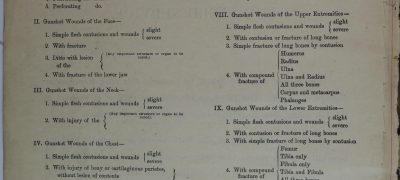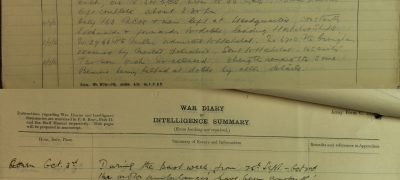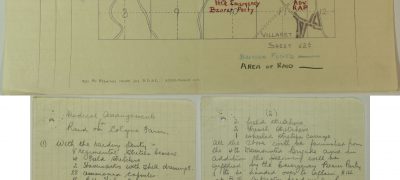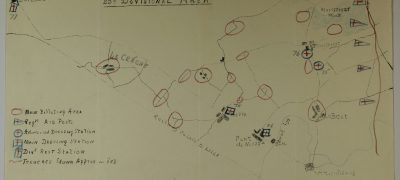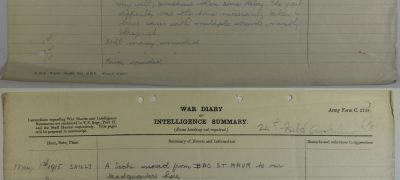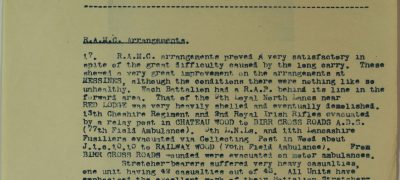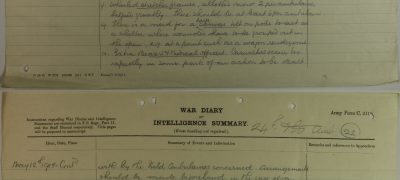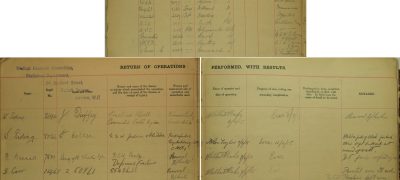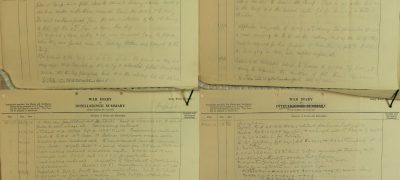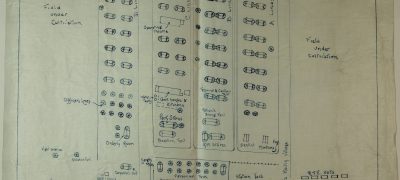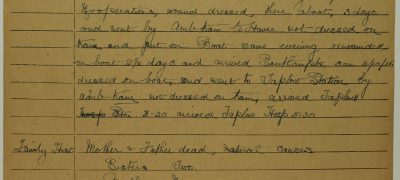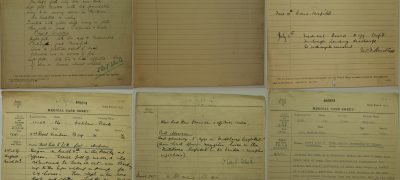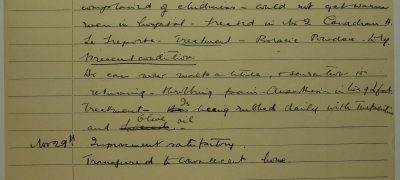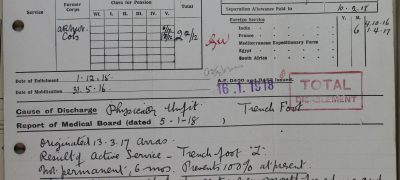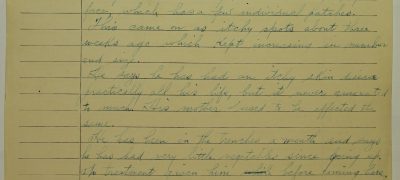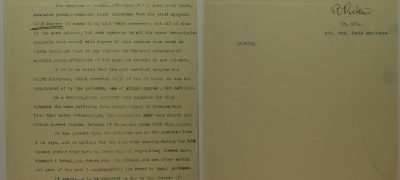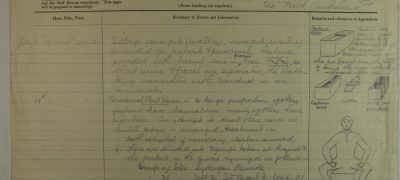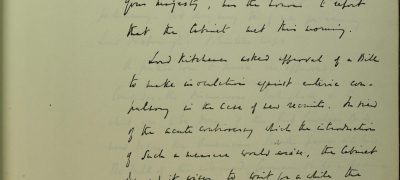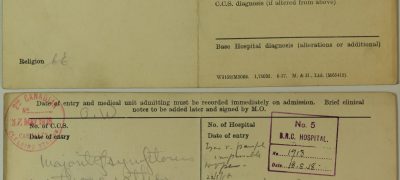Download documents and transcripts
Teachers' notes
These teachers notes can be downloaded as part of our Teachers Pack PDF. (7.2 MB)
Both these collections of original sources Part 1 and Part 2 can be used to support GCSE thematic modules which cover ‘Medicine through Time to the present day’ and the ‘historical context of the British sector of the Western Front’. Teachers have the flexibility to download and create their own resources from these documents, to develop their pupils’ understanding of how to work with sources and prepare and practice for source based exam questions. Each collection includes a wide range of sources to encourage students to think broadly when exploring these topics.
With each collection we have suggested 5 tasks based on some of the documents. The tasks can be completed individually or in groups.There is a downloadable pdf of questions (0.02 MB) to help working with sources. All documents are provided with transcripts. We hope that exposure to original source material may also foster further document research. The following themes covered by the documents in Part 1 include:
- Type of injury which resulted from trench warfare.
- Medical treatments received by injured soldiers and some of the medical developments that came with the First World War.
- Dangers faced by soldiers caused by exploding shells, grenades, shrapnel, gas, personal combat, flooding, noise, acute stress.
- Type of medical services from transport to hospitals. (For the injured, this could involve initial treatment and transport by a Field Ambulance unit and return to duty or movement to a Casualty Clearing Station. From here injured soldiers could be moved to a Base Hospital before transportation to a British military/civilian hospital at home via hospital ship. Transport itself ranged from stretcher bearers, horse-drawn ambulances, motor vehicles, boats or ships.)
- Included here also is the personal War Office record of war poet Wilfred Owen (one of a specific record set of notable high-ranking officers in the British Army).
Working with these sources:
It is fundamental when using sources that students get to grips with what they are looking at! What type of source is this? What is being said? How is it being said? For example, if looking at an army medical card, a superficial view response might be that it contains, by its nature, only limited information or only provides answers to generic questions. Encourage students to “look behind the source”. The army records included here infer a huge amount of planning and record keeping and can suggest the scale of a particular problem. Some of information contained may be limited but this suggests that the purpose was to gather statistics for medical authorities/government. Other sources, such as medical case sheets, unit war diaries, reports and pension records can be highly detailed. It is possible to understand a huge amount about how patients were assessed, examined and treated, how their cases progressed and how their treatment continued after the war. Whilst the emphasis of the sources in Part 1 centres on injuries, treatment and medical services, these also provide invaluable information about the nature of trench warfare, its organisation and impact. Part 2 includes sources which focus more specifically on the nature of trench warfare, but also documents relating to the experience of women at the front and further sources covering injuries and treatments during wartime.
When working with the photographs in these collections, students should always consider why has the photograph been taken? Does it show some kind of development or system of organisation? Can you tell if the photograph is posed, or an official war photograph? Remember too, a photograph can be selective in choice of subject or could it have been cropped? Is there an original caption linked to the photograph? Captions can add meaning to a photograph and add a particular message. They are added after the photograph was taken, therefore we must not necessarily take them on face value. It is also useful to know that many soldiers used photography to record their experiences and some carried small Vest Pocket Kodak cameras which were banned after 1915, but many continued to carry them regardless and some such photographs have survived, although examples are not included here. Finally, other soldiers were employed as official photographers during the First World War as well as newspaper photographers.
The big question when working with sources is: how can the evidence provided within the source be considered useful for a particular enquiry question? Therefore, encourage students to consider both the ‘witting’ and ‘unwitting’ testimony a source may reveal. Part of this evaluation is to consider if there are any gaps in the evidence or issues of accuracy in authorship. Why would we trust/not trust this source? What other sources might be needed to provide additional information/context? Does the document support other knowledge that you have already for a certain line of enquiry?
Always pay attention to the origin of the source. Ask students to look at the document reference. Do they know what that means? The record series/government department can contribute a whole layer of meaning to the interpretation of a given source. What does the type of record tell you (see below) about the content of the source?
General source guidance questions:
The purpose of these questions is to help students to analyse, evaluate and understand documents in order to develop their own interpretations and conclusions. Teachers may wish to print these out from pdf download and discuss them with the students before they look at the sources.
- What is the date of the source?
- Who wrote/created it?
- Do you know anything about the author?
- What type of source is it? (Letter, report or newspaper, war diary, pension record, medical record, map, diagram, photograph.)
- What is the source saying/showing?
- Check the meaning of any words you are unsure about.
- How useful is this information, does it support what you know already?
- What can you infer (information which is not directly stated)
- What type of enquiry would be this record be useful for?
- Does the document show the writer’s opinions/values?
- Are there any clues about the intended audience for the document?
- Why was the document created?
- Does it have any limitations or gaps?
- Does it link to other sources in this group?
- Does it share the same ideas, attitudes and arguments?
- How would you explain any differences between these documents?
Connections to the Curriculum
- AQA GCSE History: Conflict and tension: the First World War, 1894–1918 The Western Front: military tactics and technology, including trench warfare
- Edexcel GCSE History: Medicine in Britain, c1250 present and The British sector of the Western Front, 1914 18.
- OCR GCSE History: War and British Society c.790 to c.2010: The First World War: the beginnings of ‘total war’, including the impact on people’s lives.
- Edexcel GCE ‘A’ level History: British Experience of Warfare c1760-1918: Trench warfare on the Western Front 1914-1918
Tasks
Task 1: Getting started
Aim: to expose pupils to a range of sources available for research into trench warfare, injuries and treatments on the Western Front. Start with a survey of the type of sources in this collection.
- Ask the pupils to identify and list as many different types of sources they can find in the collection, e.g. medical army forms, photographs, medical reports, war diaries, pension records, newspaper articles etc. It is important to discuss why it is important to explore a wide range of sources on this topic. (To just focus on army medical forms for finding out about medical treatment or injury is too narrow- other record series can expand an enquiry as this task demonstrates.)
- Are there any potential source types missing in this collection? (Oral testimony, film.)
- Break the class up into groups and get students to feedback/or annotate at a white board which sources could be relevant to particular enquiry questions
- Spend time exploring what the document references stand for. Knowing which government department lies behind a particular record can be helpful and add context: For example:
MH 106 records come from the Ministry of Health. These medical records were brought together by the Medical Research Committee and the British Museum during and after First World War, for use in statistical studies of the treatment for injuries and diseases contracted by British troops. The records include admission and discharge registers to selected Field Ambulance units, Casualty Clearing Stations, Base and Home Hospitals and hospital ships. There are medical case sheets, detailing diseases, different injuries and treatments prescribed and hospital of admission in the U.K, medical cards for individuals noting the name of the soldier, nurse or civilian admitted; unit; squadron, battery or company; regimental number; rank; age; years of service with dates of discharge, transfer or death.
It is also important to stress that these records can in some cases give additional detail about individual experiences of the ordinary men who fought, give a sense of trench warfare and organisation of medical services.
WO records come from the War Office These include the unit war diaries of the British Army in the First World War series WO 95: http://discovery.nationalarchives.gov.uk/details/r/C14303. The diaries are not personal diaries, they may contain details of troop movements, daily routine, intelligence reports, maps or trench maps for example. A few contain details about awards of the Military Medal and the Meritorious Service Medal. The war diaries cover duties carried out by the battalion and can provide an insight into the conditions and experience of men in the trenches during the war. Different parts of the collection cover units serving in different theatres e.g. for France and Flanders: WO 95/1-3154, WO 95/3911-4193 and WO 95/5500.
PIN records come from Ministry of Pensions and National Insurance and the records concern war disability pension awards. These cases cover all types of disability pensions awarded after the First World War, and include files for serving men and officers, army, navy and air force, widows and dependants, and nurses. The records reflect the impact of war on people. Deafness, as a cause for disability is highlighted as a result of trench warfare and as an effect of traumatic shell-shock. Again serious cases of trench foot have been the subject of disability awards. The PIN records can show us changes in medical technology. For example records (PIN 38/450) in the series reveal the growth of companies making hearing aids to help those whose hearing was damaged by the sound of heavy explosions and guns. Again the Disablement Services Service section within PIN 38 specifically deals with the supply of artificial limbs and appliances.
ZPER records included in both these themed collections are very useful sources for this topic. They include articles and photographs and drawings from the Illustrated London News. It is important for students to consider the tone and voice of these articles and explore why particular photographs and illustrations have been selected for publication.
CAB 23/2 Cabinet Papers are a useful source for this topic and are available on our Cabinet Papers website:
https://www.nationalarchives.gov.uk/cabinetpapers/themes/total-war.htm
Students can access a series of secret cabinet conclusions (records of cabinet meetings) which were transferred to The National Archives after 30 years and released to the public. These documents cover the Western Front in First World War including: Battles of Somme, Arras, Third Battle of Ypres, Cambrai, German Offensives, Battle of Amiens and the final offensive. There is also related content on the website for these documents.
Task 2: Take four War Diary sources!
Study the following sources in Part 1: WO 95/4117 (Work of an ambulance unit); WO 95/2399 (Medical Aid behind the Front); WO 95/1703 (Collection & caring for the wounded); WO 95/1703 (Lessons learned in service) and answer the following enquiry questions:
Either: What difficulties were faced by the army medical services when dealing with injured and wounded men?
Or: Which sources explain how immediate medical care was given? Give reasons for your choice.
Extension: Use your own selection from the online documents here to answer these questions.
Task 3: What is the value of an army medical case sheet?
- Find three army medical case sheets in Part 1 with the catalogue reference MH 106 which show the chain of evacuation experienced by an injured soldier.
- How does using this type of document help us find out about how the medical services worked in the field as well as about hospital treatments?
Task 4: What problems faced medics treating gunshot and shrapnel wounds?
Study the following sources in Part 1 to discuss this enquiry question:
MH 106/297 (Injury classification); MH 106/2104 (Tetanus risk from bullets & shrapnel); ZPER 34/146 (Disinfection of wounds & first aid kit) found in Part 2 document collection.
Task 5: How useful are these two extracts from the war diary WO 95/4117 (‘RAMC medical training’) in Part 1 when enquiring into the types of injuries and treatments experienced by soldiers on the Western Front?
Introduction
Records of the medical services during the First World War reveal a great deal about the experiences of those working in the field and the soldiers they treated for a variety of injuries and diseases on the Western Front, and indeed further afield. Soldiers were exposed to many dangers from gunshot, shellfire, gas and personal combat as well as the psychological threats to their mental well-being brought on by anxiety and stress. Again conditions in the trenches brought their own health hazards. The industrial nature of the war with its new weapons and technology resulted in vast casualties. In total, medical services treated two million men in France or at home in England.
The journey from battlefield to care for a wounded soldier on the Western Front varied greatly depending on the injuries sustained. The majority of the wounded would pass through a regimental aid post, and/or an advanced dressing station. Some made their own way there, and others would be collected by the stretcher bearers from the Field Ambulance. Minor injuries would be assessed here and some minor treatments, such as the cleaning and bandaging of wounds might be carried out here. More serious injuries or significant illness would be transferred in to the Main Dressing Station which was set up to deal with a variety of medical issues. Then a man might be transferred to a Casualty Clearing station, where a triage assessment would be undertaken. The least serious cases, that needed a brief period of recovery, would be returned to duty after some rest and recuperation. Any man whose injuries were serious, but who was still fit to travel would be transferred back to base hospitals, usually known as the General Hospitals, subsequently via some form of ambulance (be that a lorry, a barge or a train) to a hospital further back beyond the lines. The most seriously ill or injured and those in need of urgent treatment would be retained at the C.C.S. until such time as their treatment was completed and their condition was stable enough to allow them to be transferred back to a General Hospital.
Casualty Clearing Stations were central to the whole process of evacuating the wounded away from the Western Front and it was in this setting that a number of significant medical innovations, such as the development of transfusions, began to be shaped. During 1915, the Director General of Medical Services approved the movement of surgical services in the C.C.S. and over the course of that year it became routine for the most serious wounds to be sent straight to the CCS, bypassing the other sections of evacuation from the front lines. During 1916, there was a move to bring the C.C.S. even closer to the frontline, in order to try and reduce deaths amongst the most severely injured men, who might bleed to death whilst waiting for transfer. During the latter years of the war, it was common for C.C.S. to be located near railway lines, but during the spring of 1918, the C.C.S. were judged to be at risk of direct enemy action and were moved back. C.C.S. included surgical theatres, preparation spaces, resuscitation wards, and in some units, x-ray equipment. The C.C.S. were managed by the Royal Army Medical Corps (RAMC) and staffed by the Queen Alexandra’s Imperial Military Nursing Service (QAIMNS), sometimes supported by nurses from the Territorial Forces Nursing Service (TFNS) and members of the Voluntary Aids Detachment (VAD). You can find some examples of these nursing service records in our second collection of documents (Part 2).
Over the course of the war, new treatments and methods for rehabilitation were refined and developed. The Roehampton centre at Queen Mary’s Hospital for example, forced in part by the scale and frequency of those who lost limbs, became a specialist limb fitting unit. Artificial limbs were made and fitted and patients would learn how to use them using hospital the gymnasium and workshops. Pioneering work was made too in the treatment of facial injuries. These were not easily treated on the front line. Surgeons would often have to stitch a wound quickly but did not take into account the amount of flesh that had been lost. Harold Gillies, a New Zealand surgeon after serving in France, saw the absolute need for specialist hospitals to deal with facial wounds and set up The Queen’s Hospital in Sidcup in 1917, the first dedicated treatment hospital of its kind.
External links
Film sources
St John in the First World War – with a particularly good film telling the story of a fictional VAD nurse: http://museumstjohn.org.uk/research/projects/st-john-first-world-war/
Students could consider British Pathe film sources as interpretations of the First World War in relation to these documents on trenches, injuries and medical treatment: https://www.britishpathe.com/
Oral testimony online
Students can explore some of the oral testimonies and eyewitness accounts available from the Imperial War Museum Sound Collections alongside the written and photographic sources available in this collection: https://www.iwm.org.uk/collections/search?
Poetry
First World War Digital Poetry Archive: http://www.oucs.ox.ac.uk/ww1lit/
Other useful links
The National Army Museum’s Birth of Plastic Surgery resource: https://www.nam.ac.uk/explore/birth-plastic-surgery/
Back to top
